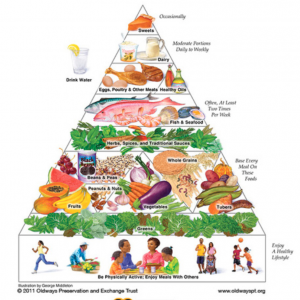Genes for HUFA formation
Two fatty acid desaturases (FADS1 and FADS2) act to produce HUFA from their 18-carbon precursors (18:2n-6 and 18:3n-3), providing a supply of n-3 and n-6 HUFA needed for brain growth and development. FADS activity is controlled by gene variations, haplotypes A and D. Haplotype D forms HUFA more rapidly than haplotype A does. Gene sequences defining the haplotypes in the primate rhesus macaques, African apes (chimpanzees and gorillas), and hominid Denisovans all have patterns similar to haplotype A.
The 75 kb distance between FADS1 and FADS2 in rhesus macaques and chimpanzees was reduced by deletion to only 11 kb in humans. This brought promoters of FADS1 and FADS2 closer to each other, and may allow more coordinated regulation of FADS expression. While haplotype D acts as a thrifty genotype providing efficient synthesis of HUFA, scientists are beginning to recognize that diets rich in 18:2n-6 make it a risk factor for chronic inflammatory disorders.
Ameur et al. estimated a divergence time of 606,000 years ago for haplotype A and 255,000 years ago for haplotype D. Haplotype D appeared after the split of the common ancestor to humans and Neanderthals 400,000 years ago, and it is specific to humans. Both haplotype A and haplotype D were present in humans at the time of the exodus from Africa 50,000–100,000 years ago. As a result, both haplotypes were present in European, Asian, and Oceanian populations as people began developing and marketing grains about 10,000 year ago. However, in Africa after the exodus, the balanced diet of n-3 and n-6 nutrients in foliage and vegetation was associated with positive selection for efficient haplotype D until it reached an almost fixed status.
A contrasting very low frequency of haplotype D in Native American populations indicates that it might have been lost by a bottleneck effect during migration across the Bering strait and colonization of the American continent. Loss of the D type was possibly aided by low selection pressure from eating an Arctic diet rich in n-3 HUFA.
Researchers recently confirmed the two forms of control over HUFA formation and noted concern that the “Modern Western Diet” has 18:2n-6 at much higher levels than 18:3n-3. This nutrient imbalance allows the efficient haplotype D to accumulate more n-6 than n-3 HUFA. A major concern comes from unintended and unwanted consequences for individuals at the upper extreme of HUFA balance (excess 20:4n-6 or low 22:6n-3). At the present, a reduction in dietary intake of 18:2n-6 and 20:4n-6 with an increase in n-3 HUFAs would likely benefit most individuals.
A sad aspect of the story of gene diversity comes from the 17th and 18th century Atlantic slave trade that forcibly moved about 12 million Africans (mainly with haplotype D) from Central and Western Africa across the Atlanti c. They left a traditional African food environment (click Figure for details) rich in foliage and vegetation that is associated with positive selection for the D-haplotype. Balanced n-3 and n-6 nutrients in foliage and vegetation allow people to accumulate balanced HUFA and be healthy. In contrast, eating increased corn and grain gives more n-6 than n-3 HUFA precursors and shifts HUFA balance toward more n-6 HUFA, especially for people with the efficient D-haplotype.
c. They left a traditional African food environment (click Figure for details) rich in foliage and vegetation that is associated with positive selection for the D-haplotype. Balanced n-3 and n-6 nutrients in foliage and vegetation allow people to accumulate balanced HUFA and be healthy. In contrast, eating increased corn and grain gives more n-6 than n-3 HUFA precursors and shifts HUFA balance toward more n-6 HUFA, especially for people with the efficient D-haplotype.
Subsequent 20th century American food marketing created a very unbalanced “Modern Western Diet” with 18:2n-6 at much higher levels than 18:3n-3. Unbalanced precursors affect HUFA balance in European Americans and Native Americans (who have low or absent proportions of the D-haplotype) in ways that can be balanced by eating seafood weekly. However, when African Americans with a dominance of the D-haplotype consume the “Modern Western Diet”, they accumulate more n-6 HUFA and increase the risk for excessive 20:4n-6 action causing chronic inflammatory disorders. They have an even greater need to eat seafood with n-3 HUFA.
All Americans now have many reasons for RECIPE REPAIR using Omega Meals software. Eating seafoods is an easy way to shift HUFA balance to lower the risk for excess omega-6 actions. While food choices alone CAN give a desired HUFA balance, some daily food combinations don’t succeed. That’s when many people use fish oil supplements to reach their goal while they continue eating prepared foods that have fairly negative scores.
The consequence of having different ethnic foods with different balances of omega-6 and omega-3 EFA nutrients is that the HUFA balance in apparently healthy people ranges from 20% to 85% omega-6.Those tissue HUFA balances relate to the risk for many unwanted inflammatory conditions and are a useful health risk assessment measurement. They can be measured in a simple finger-tip blood-spot test.
updated February, 2020
